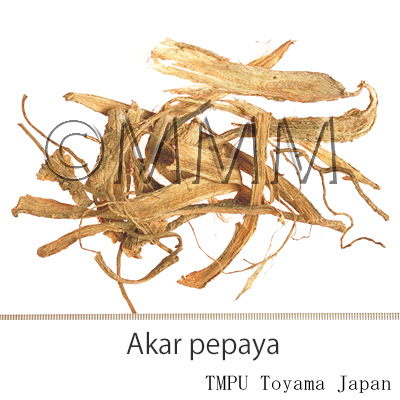Crude drug sample data base
※Click on the image to enlarge it.
Scientific information data base
| Crude drug name | Indonesian name, English name | Pepaya, Papaya | ||
|---|---|---|---|---|
| crude drug image |
| |||
| Original plant name | Carica papaya Linn. | |||
| Family name | Caricaceae | |||
| Used part | Root, leaves, flowers, fruits, seeds | |||
| Distribution area | It occurs and cultivated throughout Indonesia [201]. | |||
| Description | It is a plant with an erect branchless single trunk up to 10 m high, has a palm-like head of foliage at the top. Trunk remains succulent and soft wooded, never develops true bark. It is ringed with prominent scars from previous leaf stems and contains an acrid milky latex sap. Leaves are deeply incised and lobed, up to 61 cm across and borne on 61 cm petioles. Flowers produced along the trunk from the leaf axil, pale yellow, slightly fragrant, and generally dioecious. Fruits fleshy, indehiscent, are produced in the leaf axil close to the trunk. The smooth-skinned fruits are green, yellow, orange or rose colored. They hang on short stalks in clusters directly from the trunk beneath the umbrella of giant leaves. Seeds several.black and embedded in a sweet pulp. | |||
| Drug effect | Bitter, cooling, blood cleanser [231]. | |||
| Specific actions | Root: Anthelmintic, diuretic, stomachic; Leaves: Stomachic, emenagogue; Seeds: Anthelmintic; Latex: Anti-inflammatory [231]. | |||
| Frequency in use | Moderate | |||
| Common uses | Leaves are edible and widely used as vegetable. Raw leaves are used as an appetite stimulant for children. The unripe papaya fruit and the leaves are the source of papain, an enzyme that digests protein and that is used as a dietary supplement to aid in digestion. Papain is used as a meat tenderizer. Flowers are soaked in warm water, sun-dried and are used to make pickles which are effective as an appetite stimulant [201]. | |||
| Pharmacological effect | A research was carried out to investigate the antibacterial activity of ripe and unripe Carica papaya on selected micro-organisms. Results showed that there were no significant differences in bacterial sensitivity between immature, mature and ripe fruits. The seeds contain anti-bacterial activity that inhibited growth of gram-positive and gram-negative organisms. The antibacterial properties is useful in treating chronic skin ulcers [PMID: 15040064]. Studied on the effects of oral administration of Carica papaya seeds extract on the morphology of pituitary, testes and sex accessory glands revealed that C. papaya extract interfered with the pituitary-gonadal axis to influence male reproductive functions, which confirmed its antifertility property [PMID: 16372375]. Ethanol extracts of dried, powdered seeds of the ripe fruit extract showed hypotensive activity and depressed respiration [218]. | |||
| Medical system | Indonesian medicine (Jamu) | |||
| Traditional usage | Root is used in the treatment of kidney stones and other kidney and urinary bladder disorders, and it is used in the form of decoction as an anthelmintic against intestinal worm, liniment for rheumatic joints and muscle pains. A mixture with vinegar is used to treat headache caused by cold. Leaves are used as a cholagogue; the infusion is used for carminative, abdominal colic, anti malarial, febrifuge. Smoking a cigarette made from the leaves is used to cure asthma. Leaves are also used to treat beri-beri. Flowers are used as an appetite stimulant and blood purifier. Fruit latex is applied on skin burnt and acne. It used internally for intestinal worm infestations. Latex contains papain, and is used especially in America to treat cancer and abdomen disorders. Ripe fruits are edible and have cooling property. Unripe fruit is used against thrush. A mixture of crushed seeds with vinegar is rubbed throughout the body as sudorific in fever. Seeds can be used as anthelminthic [201]. | |||
| Formulation | 1) As anthelmintics: 1 small-sized root together with 1 clove of garlic is boiled in 100 ml of water. Strain, drink 100 ml of the infusion twice a day for 4 days [231]. | |||
| References | Reference book Tips! | [201] K. Heyne, Tumbuhan Berguna Indonesia, Vols. 1-4, 1987. Diedarkan Oleh Koperasi Karyawan Departemen Kehutanan, Jakarta, Indonesia. Vol. 3, p 1459. [207] Badan Penelitian Dan Pengembangan Kesehatan and Departemen Kesehatan, Kesejahteraan Sosial Ri. Vols. 1-5, Inventaris Tanaman Obat Indonesia, Jakarta, Indonesia. Vol. 1, Part 1 (2000), p 51. [218] Kardono L.B.S., Artanti N., Dewiyanti I.D., Basuki T., Padmawinara K.: Selected Indonesian Medicinal Plants. Monographs and Descriptions. P.T. Gramedia Widiasarana, Jakarta, Indonesia, 2003. pp 167-178. [222] P.T. Eisai Indonesia: Medical Herb Index in Indonesia (Second edition).1995. p 53. [228] Christophe, Wiart.: Medicinal Plants of Southeast Asia. Prentice Hall. Malaysia. 2002. pp 96-98. [231] Soedibyo, Mooryati: Alam Sumber Kesehatan: Manfaat dan Kegunaan (Natural resources for health. Benefits and uses). Balai Pustaka. 1998. p 298. | ||
| Research paper | 1. Udoh P, Essien I, Udoh F. Effects of Carica papaya (paw paw) seeds extract on the morphology of pituitary-gonadal axis of male Wistar rats. Phytother Res., 19(12):1065-8, 2005. (PMID: 16372375) 2. Dawkins G, Hewitt H, Wint Y, Obiefuna PC, Wint B. Antibacterial effects of Carica papaya fruit on common wound organisms. West Indian Med J., 52(4):290-2, 2003. (PMID: 15040064) | |||
| Remarks | [DNA sequences] AM113989, HM194876, DQ660982, DQ660903, AJ852507, AJ851239, AJ851006 | |||
| Last renewal date | 2024/03/12 | |||



